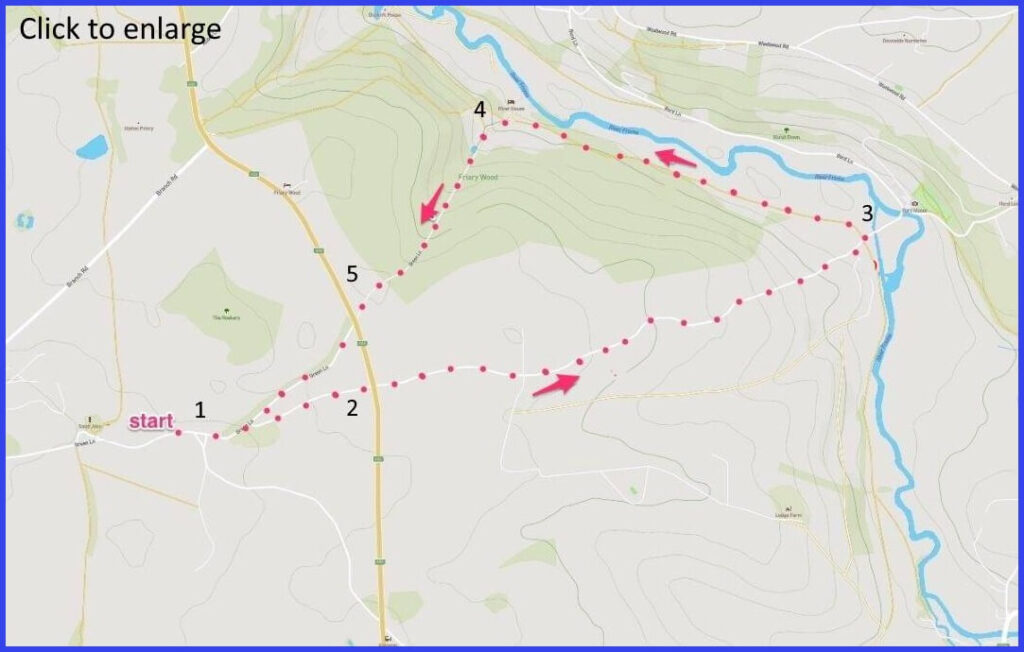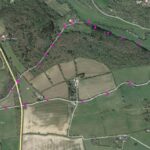(Routes suggested from each map point + metres to next point)
Start somewhere on Green Lane and walk away from the village. Dont take first right fork (with sign pointer).
1: Take the second by a dry stone wall and follow track to (busy) A36. 220m
2: Cross and follow forward the lane immediately opposite. 1.6km
3 Pause at River bridge and admire the Manor. Turn back and in a few yards find footpath entrance to fields on your right (pic F). Walk across left side of this field. 1km
4: Exit at farm and take left turn footpath that leads up through Friary Wood (pic H) finally getting back to A36 on Green Lane. 500m
5 Cross A36 once more and follow lane back to start. 725m
The pictures below are in the order things were seen on this walk. Clicking on any one will enlarge it (and the slideshow)
The walk
The walk is a mixture of both surfaces and slopes. Nothing challenging but possibilities of mud and cattle here and there. Although the first part is a just quiet lane (crossing a busy road at one point). This lane leads to Iford manner. Here a field path is taken which is long and straight – walk roughly parallel with the wooded boundary and parallel to the River Frome on the other boundary. At the end of this field, rise left through woods to a small settlement, pass up more woods to join Friary Lane, then Green Lane, then back to your starting point.
The village
The suggested route starts only on the edge of Hinton with most of it behind you. However, depending where you start on Green Lane you may see St Johns Church to your right. It is of Norman origin but what you see now is mainly 12th century.
Hinton priory
Although the walk is named here after Hinton Charterhouse, the walk start is on the edge of the village and takes you away from it. But the route does run through the heart of the land that gives the village its name. That is, the land of Hinton Priory. You are closest when you walk through Friary Wood around the middle of the route, crossing the main road (with the old priory on land to your right).
Hinton was only the second Carthusian Priory to be established in England (1227). The first was at Witham, founded by Henry II in 1172 as part of the penalty imposed by the Pope for his murder of Thomas a Becket. The circumstances of the Hinton priory’s origins were more in private hands. It was founded by the widowed but wealthy Ela Countess of Salisbury (1187-1261) who declared “to the Carthusian order all my manor of Hinton, with the advowson of the church and the park and all its other appurtenances without anything reserved to me or my heirs”. The Carthusian order demanded a particularly private, strict, and contemplative community: the land here may have fitted well with social and cultural seclusion. The monks moved here from Gloucestershire, which wasn’t working for them. The contained life does depend on a fertile setting. It is evident here.
The monks did build (so it is said) the oldest (continuously running) pub in Britain: namely, the George Inn at Norton St Philip. They built it as an outlet for their produce. However, inevitably, the priory was ‘dissolved’ in 1539 (dissolution, second round). So there is not much left by way of records. Although two weavers reported seeing a certain Brother Ballard haunting the place subsequently: Ballard was a monk who was reluctant to concede to the King (his Prior successfully covered up for him, reporting “he had been many times a lunatick”). Shakespeare in Henry VIII Act I mentions a `monk of Henton’ who, it has been suggested, might be based on Ballard. But this is challenged. It was more likely based on a certain Father Hopkyns – one who claimed powers of prophecy. Some of his predictions were not appreciated by Henry VIII – in particular the prophecy that the Duke of Buckingham (Hopkyns was his confessor) would become King (wrong, Buckingham was executed instead).
Iford manor: half way
The other major feature of the walk is the village of Iford and Iford Manor. The Wiltshire county boundary runs through this property. The manor was owned at one time or another by a selection of the great local families: the Methuens, the Ashes, the Hortons, the Yerburys. It is definitely worth visiting (if time allows – and if its one of its opening days). The house is privately occupied but its most famous feature is its Italianate gardens. These were designed by Arts and Crafts enthusiast Harold Peto between 1899 and 1933. Perhaps some may find the detail of Italian reference (in buildings and statues as well as the plants) a little overwhelmingly everywhere. The house has been used to host successful opera and jazz events in the gardens. Although these seem now to have re-sited at Bradford-on-Avon.
In front of the manor and on the river bridge (1400 but much restored), there is a statue of Britannia [E] with her shield (the trident is now lost). This was added by Peto around 1899. But there is something rather incongruous about the majesty of this figure coupled with the rather modest nature of the river she commands. Her presence is a litle melodramatic (but at least she is facing upstream).
Finally there is a cider maker attached to the manor. It includes a taphouse, so if its open you might seek refreshment.
The formidable Countess Ela
Historically, the whole area may be best known for its story of Ela, the countess. Richard I took her as ward to respect her dead father’s previous loyalty to him. He thereby arranged her marriage (aged 11) to William Longespée, his loyal half brother and illegitimate son of Henry II. William Longespee was made Earl of Salisbury and Sheriff of Wiltshire. After a full military and diplomatic life he was believed to have been poisoned when recovering from duties abroad. He became the first burial in Salisbury cathedral. Ela became Sheriff and, not re-marrying, she retained his estate and titles. This put her in the unusual position of being a female benefactor to the community (cf. Maud Heath).
Longespee had founded a Carthusian priory in Gloucestershire to ensure the well-being of his soul. But because it had not prospered he urged his wife on his deathbed to found Hinton Priory as a replacement for its community. This Ela did, and in terms that reflected her commitment to her husband and father (openly declared in terms of an insurance policy for the afterlife): “I being desirous to finish what he well begun…. I have done this for my husband’s soul, and the soul of Earl William my father, and for my salvation and that of my children, and for the souls of all my ancestors and heirs.” Yet she was certainly a genuinely devout person. She also founded (apparently on the same day in 1232) the Augustinian Abbey of Lacock (a building not seriously harmed by the dissolution and thus a good measure of a nun’s life circumstances at that time). She entered the Abbey herself in 1239 and later became the Abbess. John Aubrey (1659) comments she was “above a hundred years old: she outlived her understanding”. She was probably about 70



![[A]](https://wiltshirewalks.com/wp-content/uploads/2021/10/01hint-150x150.jpg)
![[B]](https://wiltshirewalks.com/wp-content/uploads/2021/10/02hint-150x150.jpg)
![[C]](https://wiltshirewalks.com/wp-content/uploads/2021/10/03hint-150x150.jpg)
![[D]](https://wiltshirewalks.com/wp-content/uploads/2021/10/04hint-150x150.jpg)
![[E]](https://wiltshirewalks.com/wp-content/uploads/2021/10/05hint-150x150.jpg)
![[F]](https://wiltshirewalks.com/wp-content/uploads/2021/10/06hint-150x150.jpg)
![[G]](https://wiltshirewalks.com/wp-content/uploads/2021/10/07hint-150x150.jpg)
![[H]](https://wiltshirewalks.com/wp-content/uploads/2021/10/08hint-150x150.jpg)
![[I]](https://wiltshirewalks.com/wp-content/uploads/2021/10/09hint-150x150.jpg)